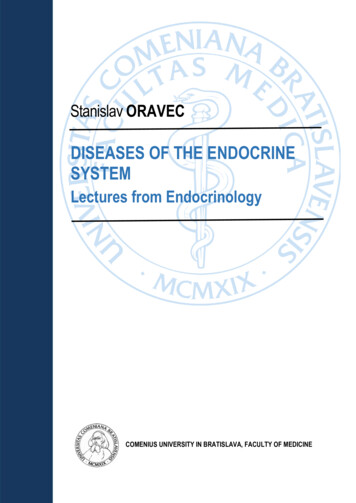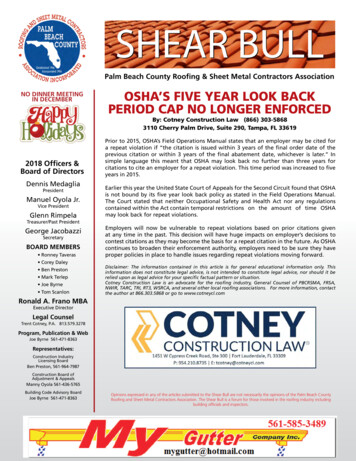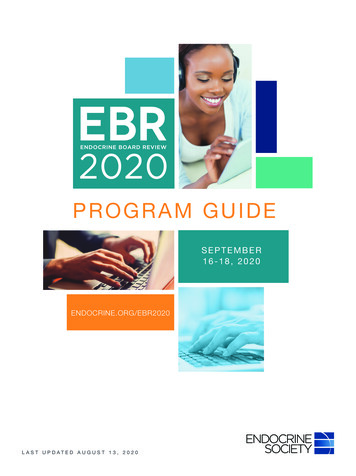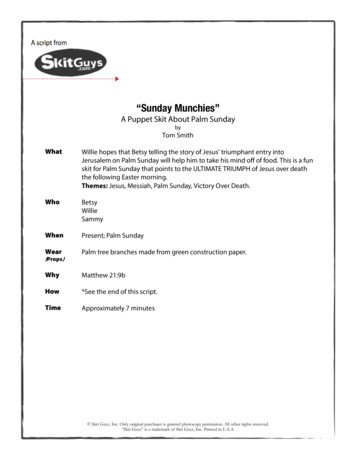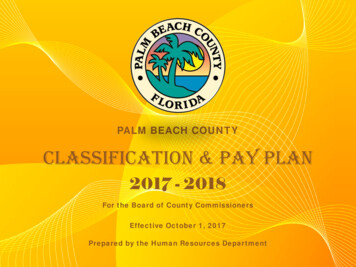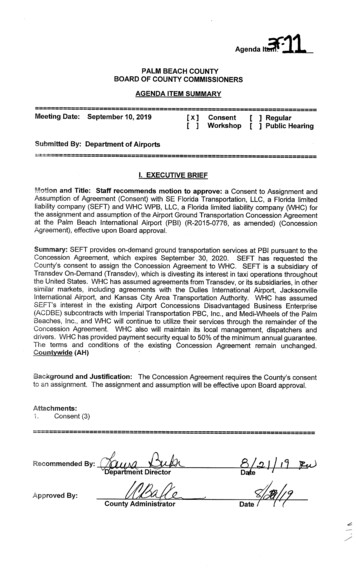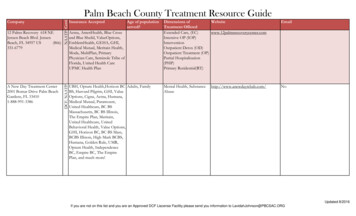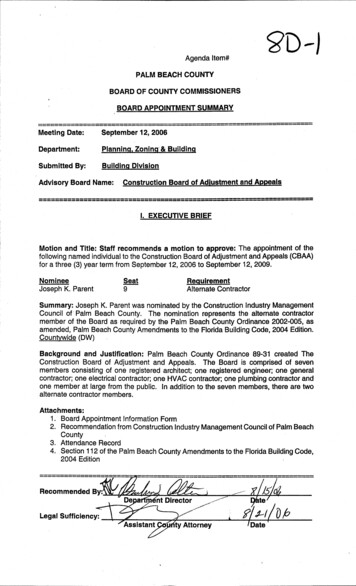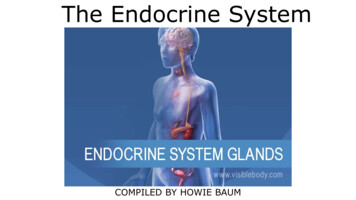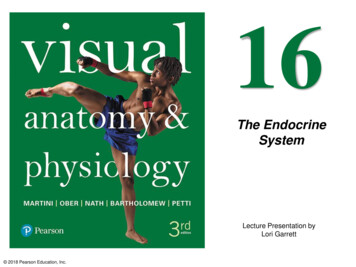
Transcription
16The EndocrineSystemLecture Presentation byLori Garrett 2018 Pearson Education, Inc.
Section 1: Hormones and IntercellularCommunicationLearning Outcomes16.1Describe the similarities between the endocrineand nervous systems and their specific modesof intercellular communication.16.2Explain the chemical classification of hormones.16.3Identify the organs and tissues of the endocrinesystem and the key functions of the hormonesthey secrete.16.4Explain the general mechanisms of hormonalaction. 2018 Pearson Education, Inc.
Section 1: Hormones and IntercellularCommunicationLearning Outcomes (continued)16.5Describe how the hypothalamus controlsendocrine organs.16.6Describe the location and structure of thepituitary gland, and identify pituitary hormonesand their functions.16.7Describe the role of negative feedback in thefunctional relationship between thehypothalamus and the pituitary gland. 2018 Pearson Education, Inc.
Section 1: Hormones and IntercellularCommunicationLearning Outcomes (continued)16.8Describe the location and structure of the thyroidgland, identify the hormones it produces, andspecify the functions of those hormones.16.9Describe the location of the parathyroid glands,and identify the functions of the hormone theyproduce.16.10 Describe the location, structure, and functions ofthe adrenal glands, identify the hormonesproduced, and specify the functions of eachhormone. 2018 Pearson Education, Inc.
Section 1: Hormones and IntercellularCommunicationLearning Outcomes (continued)16.11 Describe the location and structure of thepancreas, identify the hormones it produces,and specify the functions of those hormones.16.12 Describe the location of the pineal gland, andidentify the functions of the hormone that itproduces.16.13 Clinical Module: Explain diabetes mellitus: itstypes, clinical manifestations, and treatments. 2018 Pearson Education, Inc.
Module 16.1: The nervous and endocrinesystems release chemical messengers thatbind to target cellsSimilarities Both systems rely on the release of chemicals thatbind to specific receptors on their target cells They share many chemical messengers Called neurotransmitters in the nervous system Called hormones in the endocrine system Both regulated primarily by negative feedbackmechanisms Common goal of both is to preserve homeostasis bycoordinating and regulating other cells, tissues,organs, and systems 2018 Pearson Education, Inc.
Mechanisms of Intercellular Communication 2018 Pearson Education, Inc.
Similarities between the Nervous andEndocrine Systems 2018 Pearson Education, Inc.
Module 16.1: ReviewA. What is the common goal of the nervous andendocrine systems?Learning Outcome: Describe the similaritiesbetween the endocrine and nervous systems andtheir specific modes of intercellular communication. 2018 Pearson Education, Inc.
Module 16.2: Hormones may be amino acidderivatives, peptides, or lipid derivativesGroups based on chemical structure1. Amino acid derivatives1) Thyroid hormones– Produced by the thyroid gland2) Catecholamines– Includes epinephrine, norepinephrine, and dopamine3) Tryptophan derivatives– Melatonino Secreted by the pineal gland 2018 Pearson Education, Inc.
Hormone classes 2018 Pearson Education, Inc.
Module 16.2: Hormone classesGroups based on chemical structure (continued)2. Peptide hormones Include most hormones of body Synthesized as prohormones– Inactive precursor molecules that are converted toactive form Range from short polypeptide chains of amino acids(such as ADH and oxytocin) to small proteins (such asinsulin, GH, and prolactin) Glycoproteins may also function as hormones– Polypeptides with carbohydrate side chains– Examples: TSH, LH, FSH 2018 Pearson Education, Inc.
Hormone classes 2018 Pearson Education, Inc.
Module 16.2: Hormone classesGroups based on chemical structure (continued)3. Lipid derivatives Consist of carbon rings and side chains built fromeither fatty acids (eicosanoids) or cholesterol (steroidmolecules) Eicosanoids– Important paracrine factors that coordinate cellularactivities and enzymatic processes (such as bloodclotting) in extracellular fluidso Leukotrienes (secondary roles as hormones)o Prostaglandins (involved primarily in coordinatinglocal cellular activities) 2018 Pearson Education, Inc.
Hormone classes 2018 Pearson Education, Inc.
Module 16.2: Hormone classesGroups based on chemical structure (continued)3. Lipid derivatives (continued) Steroid hormones– Released by:o Reproductive organs (androgens by testes in males;estrogen and progesterone by ovariesin females)o Adrenal gland (corticosteroids)o Kidneys (calcitriol)– Bound to specific transport proteins in bloodo Remain in circulation longer than peptide hormones 2018 Pearson Education, Inc.
Hormone classes 2018 Pearson Education, Inc.
Module 16.2: ReviewA. Describe the structural classification ofhormones.Learning Outcome: Explain the chemicalclassification of hormones. 2018 Pearson Education, Inc.
Module 16.3: The endocrine system includesorgans and tissues with primary and secondaryhormone-secreting rolesEndocrine system overview Includes those organs whose primary function is theproduction of hormones or paracrines Hypothalamus, pituitary gland, thyroid gland, adrenalgland, pancreas (pancreatic islets), pineal gland,parathyroid glands Many other organs contain tissues that secretehormones, but endocrine function is secondary Heart, thymus, digestive tract, kidneys, and gonads 2018 Pearson Education, Inc.
The endocrine system 2018 Pearson Education, Inc.
Module 16.3: The endocrine systemEndocrine system overview (continued) Hypothalamus Secretes hormones involved in fluid balance, smoothmuscle contraction, control of hormone secretion byanterior pituitary gland Pituitary gland Secretes multiple hormones that regulate theendocrine activities of the adrenal cortex, thyroidgland, and reproductive organs, and a hormone thatstimulates melanin production 2018 Pearson Education, Inc.
The endocrine system 2018 Pearson Education, Inc.
Module 16.3: The endocrine systemEndocrine system overview (continued) Thyroid gland Secretes hormones affecting metabolic rate andcalcium ion levels in body fluids Adrenal glands The two adrenal glands secrete hormones involvedwith mineral balance, metabolic control, andresistance to stress They also release epinephrine and norepinephrineduring sympathetic activation 2018 Pearson Education, Inc.
The endocrine system 2018 Pearson Education, Inc.
Module 16.3: The endocrine systemEndocrine system overview (continued) Pancreas (pancreatic islets) Secretes hormones regulating rate of glucose uptakeand utilization by body tissues Pineal gland Secretes melatonin, which affects reproductivefunction and circadian (day/night) rhythms Parathyroid glands Secrete hormone important to regulation of calciumion levels in body fluids 2018 Pearson Education, Inc.
Module 16.3: The endocrine systemEndocrine system overview (continued) Other organs with endocrine function and what theirhormones regulate Heart—blood volume Thymus—immune response Digestive tract—digestive function coordination,glucose metabolism, appetite Kidneys—blood cell production, rate of calcium andphosphorus absorption by digestive tract, and anenzyme involved in regulating blood pressure Gonads—growth, metabolism, sexual characteristicsas well as activities of organs in reproductive system 2018 Pearson Education, Inc.
Module 16.3: ReviewA. Define endocrine system.B. Name the organs of the endocrine system.Learning Outcome: Identify the organs and tissuesof the endocrine system and the key functions ofthe hormones they secrete. 2018 Pearson Education, Inc.
Module 16.4: Hormones affect target cells afterbinding to receptors in the plasma membrane,cytoplasm, or nucleusHormones and receptors To respond to a hormone, a target cell must havethe appropriate protein receptor Without the receptor, the circulating hormone has noeffect Cells have receptors for many different hormones Different combinations of receptors producedifferential effects on specific tissues 2018 Pearson Education, Inc.
Module 16.4: Hormone bindingTwo possible receptor locations on target cells1. Receptor in plasma membrane (extracellularreceptors) Receptors for catecholamines and peptide hormones,and most eicosanoids Act as first messenger, relaying message to anintracellular intermediary (second messenger) Second messenger then affects enzyme activity andchanges cellular metabolic reactions, exertinghormone’s effects in the cell Generally involves a G protein (enzyme complexcoupled to receptor) 2018 Pearson Education, Inc.
G protein–coupled receptors 2018 Pearson Education, Inc.
Module 16.4: Hormone bindingTwo possible receptor locations on target cells(continued)1. Receptor in plasma membrane (continued) Examples of second messengers– Cyclic AMP (cAMP)o Derivative of ATPo Increased levels may activate enzymes or open ionchannels, accelerating cell metabolic activityo Decreased levels has inhibitory effect on cell– Calcium ions (Ca2 )o Generally function in combination with intracellularprotein called calmodulin to activate enzymes 2018 Pearson Education, Inc.
G protein–coupled receptors 2018 Pearson Education, Inc.
A&P Flix: Mechanism of Hormone Action:Second Messenger cAMP 2018 Pearson Education, Inc.
Module 16.4: Hormone bindingTwo possible receptorlocations on target cells(continued)2. Receptor in cytoplasm ornucleus (intracellular receptors) Steroid hormones– Lipid-soluble hormones diffusethrough plasma membrane– Alter activity of specific genes– Affect DNA transcription rate,changing pattern of protein synthesis– Change synthesis of enzyme and structural proteinsaffecting cell’s metabolic activity and structure 2018 Pearson Education, Inc.
Module 16.4: Hormone bindingTwo possible receptorlocations on target cells(continued)2. Receptor in cytoplasm ornucleus (continued) Thyroid hormones– Transported across cellmembrane by carriermediated processes– Bind to receptors onmitochondriao Increase rate of ATPproduction 2018 Pearson Education, Inc.
Module 16.4: Hormone bindingTwo possible receptorlocations on target cells(continued)2. Receptor in cytoplasm ornucleus (continued) Thyroid hormones(continued)– Bind to receptors in nucleuso Activate specific genes orchange rate of transcriptiono Affects cell’s metabolicactivity and structure 2018 Pearson Education, Inc.
Module 16.4: ReviewA. Define hormone receptor.B. Differentiate between a first messenger and asecond messenger.C. Which type of hormone diffuses across theplasma membrane and binds to receptors in thecytoplasm?Learning Outcome: Explain the generalmechanisms of hormonal action. 2018 Pearson Education, Inc.
Module 16.5: The hypothalamus exerts direct orindirect control over the activities of manyendocrine organsHypothalamus Provides highest level of endocrine function byintegrating nervous and endocrine systems Three mechanisms of integration1. Hypothalamic neurons synthesize two hormonesthat are transported to and released by the posteriorpituitary1. Antidiuretic hormone (ADH)o Synthesized by the supraoptic nuclei2. Oxytocin (OXT)o Synthesized by the paraventricular nuclei 2018 Pearson Education, Inc.
Regulation through the hypothalamus 2018 Pearson Education, Inc.
Module 16.5: The hypothalamus exerts direct orindirect controlHypothalamus (continued) Three mechanisms of integration (continued)2. Secretes regulatory hormones that controlanterior pituitary gland endocrine cells3. Contains autonomic centers that directly stimulatethe endocrine cells in the adrenal medulla– Stimulated in response to sympathetic divisionactivation– In response, adrenal medulla releases epinephrine andnorepinephrine into bloodstream 2018 Pearson Education, Inc.
Regulation through the hypothalamus 2018 Pearson Education, Inc.
Module 16.5: The hypothalamus exerts direct orindirect controlHypophyseal portal system Capillary networks and interconnecting vesselsbetween the hypothalamus and the pituitary gland(hypophysis, pituitary gland) Regulatory hormones released from the hypothalamusat the median eminence of infundibulum Move from interstitial fluid into fenestrated capillaries Carried to anterior pituitary in portal vessels (portalveins) Form second capillary network within the anteriorpituitary 2018 Pearson Education, Inc.
Module 16.5: The hypothalamus exerts direct orindirect controlHypophyseal portal system (continued) Allows hypothalamic hormones to reach target cellsin anterior pituitary directly, without mixing anddiluting in general circulation 2018 Pearson Education, Inc.
Hypophyseal portal system 2018 Pearson Education, Inc.
Module 16.5: The hypothalamus exerts direct orindirect controlHypophyseal portal system (continued) Two classes of regulatory hormones1. Releasing hormones (RH)– Stimulate synthesis and secretion of one or morehormones at anterior lobe2. Inhibiting hormones (IH)– Prevent synthesis and secretion of one or morehormones at anterior lobe 2018 Pearson Education, Inc.
Module 16.5: ReviewA. Define regulatory hormone.B. Identify the three mechanisms by which thehypothalamus integrates neural and endocrinefunction.C. Name and describe the characteristics andfunctions of the blood vessels that link thehypothalamus with the anterior lobe of thepituitary gland.Learning Outcome: Describe how thehypothalamus controls endocrine organs. 2018 Pearson Education, Inc.
Module 16.6: The anterior lobe of the pituitarygland produces and releases 7 tropichormones, while the posterior lobe releases 2hormonesPituitary gland, or hypophysis Small, oval gland nestled within sella turcica ofsphenoid bone Releases nine peptide hormones Seven from anterior lobe (adenohypophysis)– Called tropic (trope, a turning) hormones becausethey “turn on” other endocrine glands Two from posterior pituitary (neurohypophysis) All nine bind to membrane receptors and use cAMPas second messenger 2018 Pearson Education, Inc.
The pituitary gland 2018 Pearson Education, Inc.
Module 16.6: The pituitary glandHormones of the anterior lobe1. Thyroid-stimulating hormone (TSH) Targets the thyroid gland Stimulates release of thyroid hormones Released in response to thyrotropin-releasinghormone (TRH) from hypothalamus Release is decreased when thyroid hormone levelsrise (negative feedback) 2018 Pearson Education, Inc.
Module 16.6: The pituitary glandHormones of the anterior lobe (continued)2. Adrenocorticotropic hormone (ACTH) Also known as corticotropin Stimulates release of steroid hormones from adrenalcortex– Specifically those that affect glucose metabolism Released in response to corticotropin-releasinghormone (CRH) from hypothalamus 2018 Pearson Education, Inc.
Module 16.6: The pituitary glandHormones of the anterior lobe (continued) Gonadotropins Regulate activities of the gonads Released in response to gonadotropin-releasinghormone (GnRH) from hypothalamus3. Follicle-stimulating hormone (FSH)– Females: promotes ovarian follicle development and (incombination with LH) stimulates secretion of estrogens– Males: promotes maturation of developing sperm– Inhibited by inhibin (peptide released by gonads) 2018 Pearson Education, Inc.
Module 16.6: The pituitary glandHormones of the anterior lobe (continued) Gonadotropins (continued)4. Luteinizing hormone (LH)– Femaleso Induces ovulationo Promotes secretion of estrogen and progesterone Prepares body for possible pregnancy– Maleso Stimulates interstitial cells of testes to produce sexhormones (androgens), primarily testosterone 2018 Pearson Education, Inc.
Module 16.6: The pituitary glandHormones of the anterior lobe (continued)5. Growth hormone (GH) Stimulates cell growth and reproduction byaccelerating rate of protein synthesis– Skeletal muscle and chondrocytes are particularlysensitive to GH Regulated by two hypothalamic hormones– Growth hormone–releasing hormone (GH–RH)– Growth hormone–inhibiting hormone (GH–IH) Actions of growth hormone can be direct or indirect 2018 Pearson Education, Inc.
Module 16.6: The pituitary glandHormones of the anterior lobe (continued)5. Growth hormone (continued) Indirect action of growth hormone (primarymechanism)– Liver cells respond to GH by synthesizing and releasingsomatomedins (compounds that stimulate tissuegrowth) or insulin-like growth factors (IGFs)o Receptors for these on various cells in the bodyincluding skeletal muscle and cartilage Response is increased uptake of amino acids andincorporation into new proteins 2018 Pearson Education, Inc.
Module 16.6: The pituitary glandHormones of the anterior lobe (continued)5. Growth hormone (continued) Direct actions of growth hormone– Epithelial and connective tissueso Stimulates stem cell division and differentiation– Adipose tissueo Stimulates breakdown of stored triglycerides,releasing fatty acids into bloodo Tissues use these fatty acids instead of glucose togenerate ATP (called glucose-sparing effect)– Livero Stimulates breakdown of glycogen reserves,releasing glucose into bloodstream 2018 Pearson Education, Inc.
Module 16.6: The pituitary glandHormones of the anterior lobe (continued)6. Prolactin (pro-, before lac, milk) (PRL) Works with other hormones to stimulate mammarygland development In pregnancy and nursing period, stimulates milkproduction by mammary glands Released in response to several prolactin-releasingfactors Inhibited by prolactin-inhibiting hormone (PIH) Stimulated by prolactin-releasing hormones (PRH) 2018 Pearson Education, Inc.
Module 16.6: The pituitary glandHormones of the anterior lobe (continued)7. Melanocyte-stimulating hormone (MSH) Possibly released from the pars intermedia of anteriorlobe Stimulates melanocytes of skin to increase melaninproduction In adults, that portion of the anterior lobe is almostnonfunctional– Usually no MSH in circulation 2018 Pearson Education, Inc.
Module 16.6: The pituitary glandHormones of the posterior lobe1. Antidiuretic hormone (ADH) Also known as vasopressin (VP) Released in response to a variety of stimuli– Main stimulus is an increase in solute concentration ofblood (sensed by osmoreceptors) or a decrease inblood pressure or volume Primary function is to act on kidneys to retain waterand decrease urination– Also causes vasoconstriction (helps increase bloodpressure) Release is inhibited by alcohol 2018 Pearson Education, Inc.
Module 16.6: The pituitary glandHormones of the posterior lobe (continued)2. Oxytocin (okytokos, swift birth) (OXT) Released in response to sensory input– Example of a neuroendocrine response Stimulates:– Smooth muscle contraction in wall of uteruso Promotes labor and delivery– Contraction of myoepithelial cells in the mammaryglandso Promotes ejection of milk Also has unclear functions in sexual activity– Circulating levels rise during sexual arousal 2018 Pearson Education, Inc.
Hormones of the posterior lobe 2018 Pearson Education, Inc.
Module 16.6: ReviewA. Name the two lobes of the pituitary gland.B. Identify the nine pituitary hormones and theirtarget tissues.C. In a dehydrated person, how would the amountof ADH released by the posterior lobe of thepituitary change?Learning Outcome: Describe the location andstructure of the pituitary gland, and identify pituitaryhormones and their functions. 2018 Pearson Education, Inc.
Module 16.7: Negative feedback mechanismscontrol the secretion rates of the hypothalamusand the pituitary glandNegative feedback Typical control mechanism forhormone secretion Example Hypothalamic releasinghormone triggers release ofhormone by anterior pituitarygland, which triggers releaseof a second hormone by thetarget gland 2018 Pearson Education, Inc.
Module 16.7: Negative feedback betweenhypothalamus and pituitary glandNegative feedback(continued) Example (continued) Second hormone suppressessecretion of bothhypothalamic releasinghormone and pituitaryhormone 2018 Pearson Education, Inc.
Module 16.7: Negative feedback betweenhypothalamus and pituitary glandNegative feedback (continued) In some cases, bothreleasing and inhibitinghormones are part of theregulatory process Growth hormone Somatomedins released bythe liver influencehypothalamic hormones– Inhibit release of GH–RH– Stimulate release of GH–IH 2018 Pearson Education, Inc.
Module 16.7: Negative feedback betweenhypothalamus and pituitary glandNegative feedback (continued) In some cases, both releasingand inhibiting hormones are partof the regulatory process(continued) Prolactin (PRL)– PRL inhibits release of PRH(prolactin-releasing hormone)– PRL stimulates release of PIH(prolactin-inhibiting hormone) 2018 Pearson Education, Inc.
Negative feedback regulation 2018 Pearson Education, Inc.
Hormone relationships with the hypothalamus 2018 Pearson Education, Inc.
Module 16.7: ReviewA. List the hypothalamic releasing hormones.B. The release of which pituitary hormone wouldlead to an increased level of somatomedins inthe blood?C. What effects would increased circulating levelsof glucocorticoids have on the pituitarysecretion of ACTH?Learning Outcome: Describe the role of negativefeedback in the functional relationship between thehypothalamus and the pituitary gland. 2018 Pearson Education, Inc.
Module 16.8: The thyroid gland containsfollicles and requires iodine to producehormones that stimulate tissue metabolismThyroid gland gross anatomy Located on the anterior surface of thetrachea, inferior to the thyroid cartilage Composed of two lobesconnected by a narrowisthmus Size is variable Easily feltwith fingers 2018 Pearson Education, Inc.
Module 16.8: The thyroid glandThyroid gland histology Contains large numbers of thyroid follicles Hollow spheres lined by simple cuboidal epithelium Follicle cavity holds viscous colloid (fluid packed withdissolved proteins) Into that colloid, follicle cells secrete a globular proteincalled thyroglobulin– Molecule containing the amino acid tyrosine (buildingblock of thyroid hormones) Network of capillaries surrounds each follicle,transporting nutrients, wastes, and secretory products 2018 Pearson Education, Inc.
Module 16.8: The thyroid glandThyroid gland histology (continued) C (clear) cells Found between basement membrane of follicle cells Secrete hormone calcitonin (CT)– Helps to regulate calcium ion concentrations in bodyfluids 2018 Pearson Education, Inc.
Module 16.8: The thyroid glandThyroid hormone production and storage1. Iodide ions from diet delivered to thyroid gland andtaken up by follicle cells 2018 Pearson Education, Inc.
Module 16.8: The thyroid glandThyroid hormone production and storage(continued)2. Enzymes convert iodide ions to iodine atoms andattach them to tyrosine portions of thyroglobulinmolecule 2018 Pearson Education, Inc.
Module 16.8: The thyroid glandThyroid hormone production and storage(continued)3. Thyroxine (T4), with four iodine atoms andtriiodothyronine (T3), with three iodine atoms areproduced and stored in thyroglobulin 2018 Pearson Education, Inc.
Module 16.8: The thyroid glandThyroid hormone production and storage(continued)4. Follicle cells remove thyroglobulin from follicle byendocytosis 2018 Pearson Education, Inc.
Module 16.8: The thyroid glandThyroid hormone production and storage(continued)5. Lysosomal enzymes break down thyroglobulin,releasing thyroid hormones and amino acids intocytoplasm Amino acids usedto synthesize morethyroglobulin 2018 Pearson Education, Inc.
Module 16.8: The thyroid glandThyroid hormone production and storage(continued)6. T4 ( 90 percent of thyroid secretions) and T3 ( 10percent) diffuse across basement membrane andenter bloodstream 2018 Pearson Education, Inc.
Module 16.8: The thyroid glandThyroid hormone production and storage(continued)7. 75 percent of T4 and 70 percent of T3 moleculestravel in the blood attached to transport proteins(thyroid-binding globulins) Hormones are released by proteins gradually Most of the rest of T4 and T3 attach to transthyretinor albumin– Bloodstream contains 1 week of reserve supply 2018 Pearson Education, Inc.
Production and storage of thyroid hormone 2018 Pearson Education, Inc.
Effects of thyroid hormone on peripheraltissues 2018 Pearson Education, Inc.
Module 16.8: ReviewA. What thyroid hormone aids in calciumregulation?B. Name the hormones of the thyroid gland.C. Why do signs and symptoms of decreasedthyroxine concentration not appear until about aweek after a thyroidectomy (surgical removal ofthe thyroid gland)?Learning Outcome: Describe the location andstructure of the thyroid gland, identify thehormones it produces, and specify the functions ofthose hormones. 2018 Pearson Education, Inc.
Module 16.9: Parathyroid hormone, producedby the parathyroid glands, is the primaryregulator of blood calcium ion levelsParathyroid gland anatomy Two pairs embedded in posterior surface of thethyroid gland 2018 Pearson Education, Inc.
Module 16.9: The parathyroid glandParathyroid gland cells Contain two cell populations1. Oxyphil cells (no known functions)2. Parathyroid (principal) cells Produce parathyroid hormone (PTH)– Increases calcium levels in extracellular fluids Monitor calcium levels in blood (like thyroid C cells)– When calcium levels fall below normal, PTH is released– Causes increase in calcium levels 2018 Pearson Education, Inc.
Parathyroid histology 2018 Pearson Education, Inc.
Module 16.9: The parathyroid glandCalcium homeostasis PTH and calcitonin (from the thyroid gland) haveopposing effects In healthy adults, PTH (along with calcitriol) isprimary regulator of circulating Ca2 concentrations Removal of thyroid gland has no effect on Ca2 – Dietary intake and metabolic demand balanced so thatincreased calcium levels are very rare Calcitonin can be administered clinically in metabolicdisorders with excessive calcium and excessive boneformation 2018 Pearson Education, Inc.
Calcium homeostasis 2018 Pearson Education, Inc.
Calcium homeostasis 2018 Pearson Education, Inc.
Effects of parathyroid hormone on peripheralTissues 2018 Pearson Education, Inc.
Module 16.9: ReviewA. Describe the locations of the parathyroidglands.B. Explain how parathyroid hormone increasesblood calcium level.C. Decreased blood calcium level would result inincreased secretion of which hormone?Learning Outcome: Describe the location of theparathyroid glands, and identify the functions of thehormone they produce. 2018 Pearson Education, Inc.
Module 16.10: The adrenal hormones areinvolved in metabolic regulation, electrolytebalance, and stress responsesAdrenal gland gross anatomy Also called the suprarenal(supra, above ren, kidney)gland Sits on superior border of eachkidney Retroperitoneal (like thekidneys) Only anterior surface coveredby parietal peritoneum Rich supply of blood vessels 2018 Pearson Education, Inc.
Module 16.10: Adrenal glandsAdrenal gland layers Adrenal capsule Thin, outer connective tissue Adrenal cortex (outer region) Yellowish in color– Due to stored lipids, especially cholesterol and variousfatty acids Produces more than 24 steroid hormones collectivelyknown as corticosteroids– Affect metabolism of target cells– Vital to maintaining life Adrenal medulla (inner region) Produces epinephrine and norepinephrine 2018 Pearson Education, Inc.
Module 16.10: Adrenal glandsAdrenal cortex zones and hormones1. Zona glomerulosa Outer region of the adrenal cortex Secretes mineralocorticoids(primarily aldosterone)– Increases renal reabsorptionof Na and watero Especially in presence of ADH– Accelerates renal loss of K Release stimulated by decreasedblood pressure and volume throughrenin-angiotensin-aldosterone system and inhibitedby hormones opposing that system 2018 Pearson Education, Inc.
Module 16.10: Adrenal glandsAdrenal cortex zones andhormones (continued)2. Zona fasciculata (fasciculus,little bundle) Large, central portion of adrenalcortex Secretes glucocorticoids– Primarily cortisol andcorticosterone– Liver converts some cortisol tocortisone Secretion stimulated by ACTHfrom anterior pituitary gland 2018 Pearson Education, Inc.
Module 16.10: Adrenal glandsAdrenal cortex zones and hormones (continued)2. Zona fasciculata (continued) Actions of glucocorticoids– Affect glucose metabolismo Increase rates of liver glucose and glycogenformationo Stimulate release of amino acids from skeletalmuscleso Stimulate release of lipids from adipose tissueo Promote lipid catabolism– All supplement glucose-sparing effects of GH– Cortisol also has an anti-inflammatory effect Secretion stimulated by ACTH 2018 Pearson Education, Inc.
Module 16.10: Adrenal glandsAdrenal cortex zones andhormones (continued)3. Zona reticularis (reticulum,network) Forms narrow band borderingeach adrenal medulla Secretes small quantities ofandrogens stimulated by ACTH– May be converted to estrogensin bloodstream– Minimal effects in normal adults– Stimulate development of pubichair (in both males and females)before puberty 2018 Pearson Education, Inc.
Module 16.10: Adrenal glandsAdrenal medulla Secretes epinephrine andnorepinephrine Actions of these hormones Increased cardiac activity Increased blood pressure Increased glycogen breakdownand blood glucose Secreted in response tosympathetic nervous systemstimulation 2018 Pearson Education, Inc.
Module 16.10: ReviewA. Name the regions and zones of an adrenalgland from superficial to deep.B. Cite the hormones secreted by each region ofan adrenal gland.C. What effect would increas
oIncreased levels may activate enzymes or open ion channels, accelerating cell metabolic activity oDecreased levels has inhibitory effect on cell –Calcium ions (Ca2 ) oGenerally function in combination with intracellular prote
